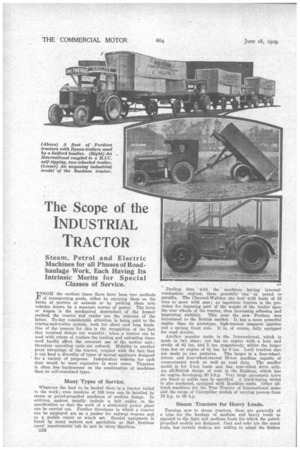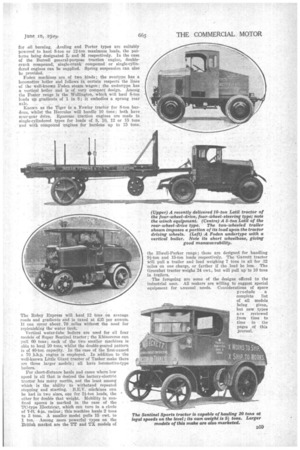The Scope of the INDUSTRIAL TRACTOR
Page 136

Page 137

If you've noticed an error in this article please click here to report it so we can fix it.
F0111 the earliest times there have been two methods of transporting goods, either by carrying them on the backs of porters or animals or by packing them into vehicles drawn by a separate source of power. The lorry or wagon is the mechanical descendant . of the former method, the tractor and trailer are the outcome of the latter. To-day considerable attention is being paid to the tractor-and-trailer 'systein, both for short and long hauls. One of the reasons for this is the recognition of the fact that terminal delays are wasteful; when a tractor can be used with relays of ,trailers the loading and unloading times need hardly affect the constant use of the motive unit; therefore operating costs are reduced. Mobility is another great advantage of the tractor, coupled with the fact that it can haul a diversity of types of Special -appliance designed for a variety of purposes. Independent vehicles for each duty would be more expensive in most cases. Taxation is often less burdensome on the combinatien of machines
than on self-contained types. •
Many Types of Service. . . . 'Whatever the load to, be hauled there is a tractor suited to the work; even burdens of 100 tons can be handled by steam or petrol-propelled machines of modern design. In addition makers usually. include a belt pulley in the specification so that the work of a 'stationary power .plant can be carried out. Further directions in which a tractor can be employed are as a pusher for railway wagons and as a mobile crane or winch set. Special equipment is listed by many makers and specialists so that business' users' requirethents' ban be -met ' D58 Dealing first with the Machines having internalcombustion engines, these generally run on petrol or paraffin. The Chenard-Walcker can deal with loads of 15 tons or more with ease; an ingenious feature is the provision for imposing part of the weight of the trailer upon the rear wheels of the tractor, thus increasing adhesion and improving stability. This year the new Fordson was introduced tothe British market. It has a more powerful engine than its prototype, high-tension magneto ignition and a sprung front axle. It is, of course, fully equipped for road service. Another popular make is the International, which is made in two sizes; one has an engine with a bore and stroke of 41 ins. and 5 ins, respectively, whilst the larger type has an engine of ins, by 6 ins. Latil tractors also are made in two patterns. The larger is a four-wheel driven and four-wheel-steered 10-ton machine capable of cross-country work as well as road duty. The smaller model is for 5-ton loads and has rear-wheel drive only. An all-British design of note is the Rushton, which has an engine developing 50 b.h.p. Very large pneumatic tyres are fitted or solids may be specified. A track-laying model is also marketed, equipped with Roadless units. Other alltrack machines are the Trac Tractor of International make and the range of Caterpillar models of varying powers from 10 hp. to 60 h.p.
Steam Tractors for Heavy Loads.
Turning now to steam tractors, these are generally of a type for the haulage of medium and heavy loads as opposed to the light and medium leads for which the petrolpropelled models are designed. Coal and coke are the usual fuels, but certain makers are willing to adapt the firebox
for oil burning. Aveling and Porter types are suitably powered to haul 8-ton or 12-ton maximum loads, the patterns being designated L and M respectively. In the case of the Burrell general-purpose traction engine, doublecrank compound, • single-crank compound or single-cylindered engines can be supplied. Spring suspension can also be provided.
Foden machines are of two kinds; the overlype has a locomotive boiler and follows in certain respects the lines
• of thewell-known Foden steam wagon ; the undertype has a vertical boiler and is of very compact design. Among the Foster range is the Wellington, which will haul 8-ton loads up gradients of 1 in 8; it embodies a sprung rear
axle. .
Known as the Tiger is a Fowler tractor for 8-ton burdens, whilst the Hercules will handle 10 tons ; both have spur-gear drive. Ransome• traction engines are made in single-eylindered types for loads of 8, 10, 12 or 15 tons • and with compound engines for burdens up to 15 tons.
The Robey Express will haul 12 tons on average roads and gradients-and is taxed at C)5 per annum. It can cover about 70 miles without the need for replenishing thewater tank.
Vertical water-tube boilers are used for all four models of Super Sentinel tractor; the Rhinoceros can pull 60 tons; each of the two smaller machines is able to haul 20 tons, whilst the double-geared pattern is of 40-tor, capacity. In the case of the first-named a 70 b.h.p. engine is employed. In addition to the well-known Little Giant tractor of Tasker make there :ire three larger models; all have locomotive-type boilers.
For short-distance hauls and cases where low speed is all that is desired the battery-electric tractor has many merits, not the least among which is the ability to withstand repeated stopping and starting. B.E.V. mIchines can he had in two sizes, one for 21-ton loads, the other for double that weight. Mobility in confined spaces is marked in the case of the TO-type Electricar, which can turn in a circle of 7-ft. 4-in, radius; this machine hauls 2 tons to 3 tons. A. smaller model pulls 15 cwt. to ton. Among more powerful types on the British market are the TT and TX models of the Elwell-Parker range; these are designed for handling 9i-ton and 15-ton loads respectively. The Garrett tractor *ill pull a trailer and load weighing 7 tons in all for 32 miles on one charge, or farther if the _load be less. The Greenbat tractor weighs 24 cwt., but will pull up to 10 tons in trailers.
The foregoing are some of the designs offered to the industrial user. All makers are willing to suggest special equipment for unusual needs. Considerations of space preclude a complete list of all models being given, but new types are reviewed from time to time in the pages of this journal.








































































































































































































